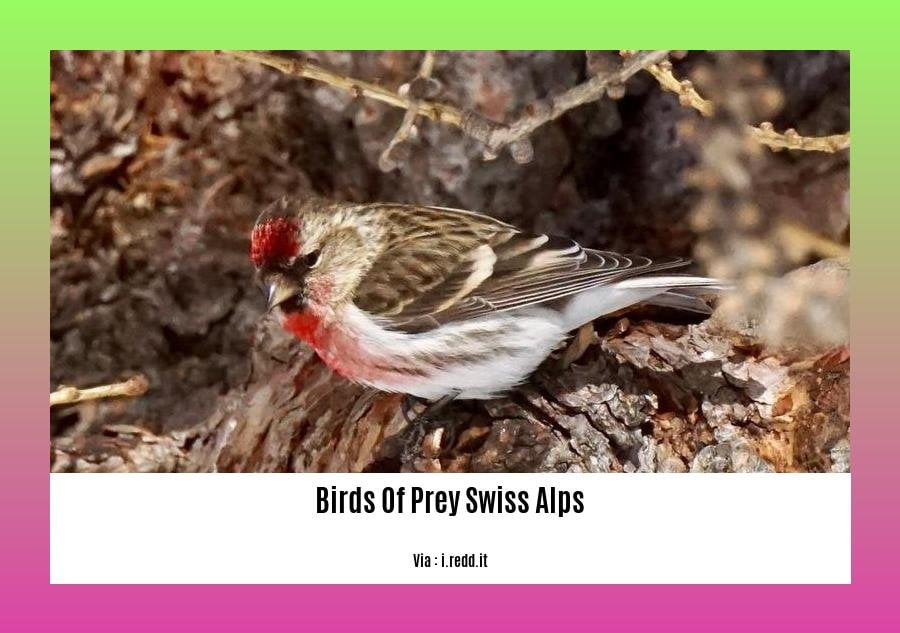Birds of Prey in the Swiss Alps: Unveiling the Majestic World
Discover the awe-inspiring world of birds of prey in the Swiss Alps. This incredible alpine region is not only known for its breathtaking landscapes and charming villages but also for being a haven for a diverse array of avian species. With their commanding presence and unparalleled beauty, birds of prey captivate both the hearts and imaginations of wildlife enthusiasts and nature lovers. In this article, we will delve into the fascinating lives of these majestic creatures, exploring their behavior, habitat, and the dedicated conservation efforts aimed at preserving their existence. Join us on a journey to unravel the secrets of the birds of prey that grace the stunning backdrop of the Swiss Alps.
Key Takeaways:
- Switzerland is home to a diverse range of bird species, particularly birds of prey.
- Notable birds of prey in the Swiss Alps include the White-Tailed Eagle, Golden Eagle, European Honey Buzzard, Eurasian Sparrowhawk, Little Owl, Booted Eagle, Red Kite, and Lesser Spotted Eagle.
- Each of these birds has unique characteristics and can be easily identified by their distinctive appearances.
- Observing these majestic birds of prey adds to the natural beauty of the Swiss Alps.
- For a more comprehensive list of bird species in Switzerland, you can refer to the provided sources.
Birds of Prey in the Swiss Alps: Unveiling the Majestic World

Switzerland’s breathtaking landscapes are not only a feast for the eyes, but they also provide a haven for a diverse range of bird species, including the magnificent birds of prey. These aerial predators grace the skies of the Swiss Alps, adding to the natural beauty of the region. In this article, we will delve into the mesmerizing world of birds of prey, exploring their intriguing behavior, habitat, migration patterns, and the conservation efforts aimed at their protection.
Awe-inspiring Species in the Swiss Alps
The Swiss Alps offer a suitable habitat for several remarkable birds of prey, each with its own unique characteristics and allure. Let’s take a closer look at some of the notable species that can be observed soaring in the alpine skies.
White-Tailed Eagle (Haliaeetus albicilla): Known as the sea eagle, the white-tailed eagle is the largest bird of prey found in Switzerland. With its impressive wingspan and stunning white tail, it commands attention wherever it flies.
Golden Eagle (Aquila chrysaetos): The golden eagle is another iconic inhabitant of the Swiss Alps. With its majestic presence and formidable hunting skills, this magnificent bird stands out with its dazzling golden-brown plumage.
European Honey Buzzard (Pernis apivorus): The European Honey Buzzard is a specialized bird of prey known for its unique feeding habits. Feeding primarily on insects, especially honeybee larvae, it can be identified by its broad wings and reddish-brown plumage.
Eurasian Sparrowhawk (Accipiter nisus): Despite its small size, the Eurasian Sparrowhawk possesses remarkable agility and hunting prowess. With its short wings and long tail, it expertly maneuvers through dense forests to catch small birds and mammals.
Little Owl (Athene noctua): While not strictly a bird of prey, the little owl is a charming species commonly found in Switzerland. With its endearing appearance, characterized by a small stature, yellow eyes, and ear tufts, it captures the hearts of many bird enthusiasts.
Booted Eagle (Hieraaetus pennatus): The booted eagle, a medium-sized bird of prey, graces the Swiss Alps during migration seasons. Its light-colored plumage and striking yellow eyes make it a beautiful sight in the sky.
Red Kite (Milvus milvus): The red kite, with its deeply forked tail and reddish-brown plumage, is a medium-sized bird of prey that effortlessly glides through the air. Its mesmerizing flight patterns and scavenging behavior make it an iconic sight in the Swiss Alps.
Lesser Spotted Eagle (Clanga pomarina): As its name suggests, the lesser spotted eagle is a smaller eagle species found in Switzerland. With its dark plumage adorned with distinctive white spots, spotting this rare creature in the Swiss Alps is a truly special experience.
Appreciating the Diversity and Conservation Efforts
These examples are just a glimpse of the incredible diversity of birds of prey that inhabit the Swiss Alps. To gain a more comprehensive understanding of the various bird species found in Switzerland, you can refer to the “List of Birds of Switzerland”.
It is essential to not only appreciate the beauty of these birds of prey but also to actively participate in their conservation efforts. Organizations dedicated to preserving the natural habitats and promoting awareness about the importance of birds of prey play a crucial role in their long-term survival. By supporting these initiatives, individuals can contribute to maintaining the delicate balance of the Swiss Alps’ ecosystem and ensure the continued existence of these majestic creatures.
Conclusion
Birds of prey in the Swiss Alps offer an awe-inspiring sight, captivating visitors with their elegance and hunting prowess. From the mighty white-tailed eagle to the agile Eurasian Sparrowhawk, each species contributes to the enchanting tapestry of the alpine landscape. By exploring their fascinating behavior, habitat, migration patterns, and conservation efforts, we can deepen our appreciation for these majestic creatures while actively working towards their protection. So next time you find yourself in the Swiss Alps, keep your eyes to the sky and prepare to witness the mesmerizing world of birds of prey in all its glory.
If you’re fascinated by birds of prey in Ireland, you won’t want to miss out on the opportunity to spot these majestic creatures in their natural habitat. Explore the world of birds of prey in Ireland and discover the diverse species that call this beautiful country home. Click here to dive into the thrilling world of Irish raptors: birds-of-prey-in-ireland.
For an equally remarkable experience, venture up north and uncover the captivating world of birds of prey in Northern Ireland. From stunning landscapes to awe-inspiring feathered hunters, there’s something for every nature enthusiast. Delve into the wonders of Northern Irish raptors by clicking here: birds-of-prey-in-northern-ireland.
One of the most iconic birds of prey in Ireland, the buzzard, holds a special place in the hearts of both locals and visitors alike. Discover the enchanting world of the birds of prey Ireland buzzard and witness their soaring flight and hunting prowess firsthand. Are you ready for an unforgettable encounter with these magnificent creatures? Don’t miss out, click here: birds-of-prey-ireland-buzzard.
Behavior and Hunting Techniques of Birds of Prey in the Swiss Alps

Birds of prey in the Swiss Alps exhibit fascinating behavior and hunting techniques that showcase their adaptability and predatory prowess. From soaring high above the mountains to executing lightning-fast ambush attacks, these majestic creatures employ a range of strategies to catch their prey. Let’s dive into the mesmerizing world of birds of prey in the Swiss Alps and uncover their remarkable hunting techniques.
Hunting Techniques
Ambush Attacks: The first technique [Behavior and hunting techniques of birds of prey in the Swiss Alps] employed by birds of prey is the element of surprise. With their exceptional vision, they spot potential prey from a distance and swiftly swoop down for a surprise attack.
Soaring and Scanning: Eagles, with their magnificent eyesight, soar high above the ground, scanning the landscape for any movement. Once they spot their prey, they descend rapidly to capture it.
Stealthy Stalking: Falcons and hawks are masters of stealthy hunting. They patiently observe their prey from a concealed position and then pounce or dive down for the perfect strike.
Aerial Acrobatics: Peregrine falcons, known for their incredible speed and agility, engage in high-speed chases and perform impressive aerial maneuvers to catch prey mid-flight.
Cooperative Hunting: Some birds of prey, like Harris’s hawks, work together in small groups for cooperative hunting. By targeting and capturing larger prey, they increase their chances of success.
Birds of Prey in the Swiss Alps
The Swiss Alps provide a majestic backdrop for a diverse range of birds of prey. Below are some notable species that grace the alpine region:
- White-Tailed Eagle (Haliaeetus albicilla): Europe’s largest eagle, known for its majestic presence in the Swiss Alps.
- Golden Eagle (Aquila chrysaetos): Symbolizing majesty across cultures, the golden eagle is an impressive predator soaring through the skies.
- European Honey Buzzard (Pernis apivorus): Despite its name, this bird possesses fascinating hunting abilities and is captivating to observe.
- Eurasian Sparrowhawk (Accipiter nisus): One of the most widespread birds of prey in Switzerland, it showcases excellent hunting skills.
- Little Owl (Athene noctua): Though small in stature, the little owl demonstrates charming personality and effective hunting strategies.
Conservation Efforts
Conservation is essential for the survival of birds of prey in the Swiss Alps. Habitat loss and human-related factors have contributed to population declines in some species. To ensure their long-term existence, various organizations are dedicated to preserving their habitats and raising awareness. By supporting these initiatives, individuals can contribute to maintaining the delicate balance of the Swiss Alps’ ecosystem and protect these majestic creatures.
Key Takeaways:
- Birds of prey in the Swiss Alps employ a combination of hunting techniques, including ambush attacks, soaring and scanning, stealthy stalking, aerial acrobatics, and cooperative hunting.
- Notable species found in the Swiss Alps include the White-Tailed Eagle, Golden Eagle, European Honey Buzzard, Eurasian Sparrowhawk, and Little Owl.
- Conservation efforts focused on preserving habitats and increasing awareness are crucial for the long-term survival of birds of prey in the Swiss Alps.
Sources:
- Birds Group. “The Hunting Techniques of Birds of Prey.” birdsgrouping.com
- Wild Bird World. “What Birds of Prey can be seen in Switzerland?” wildbirdworld.com
Migration Patterns and Seasonal Variations in Bird Populations
Birds of prey in the Swiss Alps showcase fascinating migration patterns and display seasonal variations in their populations. Understanding these patterns and variations is crucial for appreciating the mesmerizing world of these majestic creatures.
Altitudinal Migration: Responding to Seasonal Changes
Birds of prey in the Swiss Alps exhibit altitudinal migration, which means their movements are influenced by changes in altitude and temperature. During colder months, they migrate to lower elevations where food is more readily available and temperatures are comparatively milder. As spring arrives, they gradually ascend to higher altitudes for breeding and nesting purposes.
Predictable Migration Times: Harmony with Nature’s Rhythms
Migration among birds of prey in the Swiss Alps follows a highly cyclical pattern. They have well-defined nesting seasons, overwintering periods, and predictable migration times. These patterns align with the seasons and availability of resources, showcasing their remarkable adaptation to the natural rhythm of their environment.
Mapping Global Diversity: Insights from Bird Migration
Studying the migration patterns of birds in the Swiss Alps not only provides valuable insights into their behavior but also helps in mapping global patterns of migratory bird diversity. By analyzing their movement across different regions and continents, scientists can better understand the interconnectedness of ecosystems and the importance of conservation efforts.
Species Traits: Shaping Migration Patterns
Migration patterns in birds of prey are influenced by various species traits, such as altitudinal range shifts and seasonal distribution shifts. These traits impact their adaptability and ability to find suitable habitats and food sources throughout the year. By observing these patterns, researchers can gain a deeper understanding of the factors shaping bird populations.
Conservation and Global Ecology: The Significance of Bird Migration
Bird migration is of immense importance both in terms of bird conservation and understanding global ecology. By studying the patterns and processes of bird migration, scientists can gain insights into the health of ecosystems and monitor any changes that may result from environmental factors. Understanding these migration patterns is crucial for implementing effective conservation measures and preserving the delicate balance of the Swiss Alps’ ecosystem.
These migration patterns and seasonal variations in bird populations highlight the remarkable adaptability and intricacies of birds of prey in the Swiss Alps. By appreciating and studying their movements, we can gain a deeper connection with nature and contribute to their conservation.
Sources:
– Newton, I. (2003). Geographical Patterns in Bird Migration. Springer. Link
– Birdfact. Migratory Routes and Patterns in Birds: Navigating the … Link
Key Takeaways:
- Birds of prey in the Swiss Alps exhibit altitudinal migration, responding to seasonal changes in altitude and temperature.
- Migration among birds of prey follows well-defined nesting seasons, overwintering periods, and predictable migration times.
- Studying bird migration helps map global patterns of migratory bird diversity and provides insights into ecosystem interconnectedness.
- Species traits like altitudinal range shifts and seasonal distribution shifts shape migration patterns in birds of prey.
- Understanding bird migration is crucial for bird conservation and gaining insights into global ecology.
Birds of Prey in the Swiss Alps: Unveiling the Majestic World
The Swiss Alps are not only home to breathtaking landscapes but also to a diverse range of birds of prey. These magnificent creatures showcase their impressive hunting techniques and exhibit a perfect blend of brutality and elegance. In this article, we will delve into the fascinating world of birds of prey, explore their hunting strategies, and shed light on the conservation efforts and initiatives dedicated to protecting them in the Swiss Alps.
Hunting Techniques
Birds of prey have developed various hunting techniques that allow them to catch their prey effectively. Let’s take a closer look at some of their remarkable strategies:
Ambush Attacks: Birds of prey excel at using the element of surprise. With their sharp vision, they spot potential prey from a distance and swiftly swoop down for a surprise attack.
Soaring and Scanning: Eagles, with their incredible eyesight, soar high above the ground, scanning the landscape for any movement. Once they spot their prey, they descend rapidly to capture it.
Stealthy Stalking: Falcons and hawks employ stealthy tactics while hunting. They patiently observe their prey from concealed positions, waiting for the perfect moment to pounce or dive down.
Aerial Acrobatics: Some birds of prey, like the peregrine falcon, showcase extraordinary speed and agility in the air. They engage in high-speed chases, performing impressive aerial maneuvers to catch their prey mid-flight.
Cooperative Hunting: Certain birds of prey, such as Harris’s hawks, work together in small groups to target and capture larger prey. This cooperative strategy increases their chances of success.
Birds of Prey in the Swiss Alps
The Swiss Alps provide a habitat for several remarkable species of birds of prey. Here are some notable ones found in this breathtaking region:
White-Tailed Eagle: This majestic eagle, known as Haliaeetus albicilla, is Europe’s largest eagle and leaves a lasting impression with its grandeur.
Golden Eagle: The golden eagle, scientifically known as Aquila chrysaetos, holds a symbol of majesty across cultures. Its impressive hunting skills make it a formidable predator.
European Honey Buzzard: Contrary to its name, the European honey buzzard (Pernis apivorus) possesses captivating hunting abilities that make it a fascinating species to observe.
Eurasian Sparrowhawk: Accipiter nisus, the Eurasian sparrowhawk, is one of the most widespread birds of prey in Switzerland. Its excellent hunting skills have earned it a prominent place in the avian world.
Little Owl: Despite its diminutive size, the little owl (Athene noctua) possesses a charming personality and effective hunting strategies that captivate bird enthusiasts.
Conservation Efforts and Initiatives to Protect Birds of Prey in the Swiss Alps
Conservation efforts are crucial for preserving the delicate balance of the Swiss Alps’ ecosystem and ensuring the survival of birds of prey. Various organizations and initiatives are actively working towards safeguarding these majestic creatures. Here are some key conservation efforts:
BirdLife Switzerland: BirdLife Switzerland has dedicated 100 years to protecting nature, including extensive efforts to prevent the local extinction of species and create new habitats for birds.
Tropical Ecosystem Conservation: Tropical ecosystems present unique challenges for bird conservation. Understanding these challenges and implementing appropriate conservation measures is vital for protecting bird species in these regions.
Migratory Bird Conservation: Migratory birds play a crucial role in maintaining healthy bird populations and the ecosystem services provided by their movements. Efforts aimed at conserving their habitats and ensuring safe migration routes are essential.
Indicator Species for Habitat Health: Birds of prey serve as important indicators of the overall health of their habitat. Monitoring their population numbers provides valuable insights into the abundance of prey and plant foods in the ecosystem.
Bird of Prey Sanctuary: The Bird of Prey Sanctuary, operated by the PanEco Foundation in Switzerland, has been working tirelessly since 1956 to protect birds of prey and owls in Berg am Irchel.
By supporting and actively participating in these conservation efforts, individuals can contribute to the long-term survival of birds of prey in the Swiss Alps and help maintain the delicate balance of the ecosystem.
Key Takeaways:
- Birds of prey in the Swiss Alps exhibit a range of hunting techniques that combine brutality and elegance.
- Ambush attacks, soaring and scanning, stealthy stalking, aerial acrobatics, and cooperative hunting are among the strategies employed by birds of prey.
- Notable species of birds of prey in the Swiss Alps include the White-Tailed Eagle, Golden Eagle, European Honey Buzzard, Eurasian Sparrowhawk, and Little Owl.
- Conservation efforts are essential for preserving the delicate balance of the Swiss Alps’ ecosystem and ensuring the survival of birds of prey.
- Organizations like BirdLife Switzerland and the Bird of Prey Sanctuary work diligently to protect and preserve these majestic creatures.
- Supporting conservation initiatives allows individuals to contribute to the long-term survival and conservation of birds of prey in the Swiss Alps.
Sources:
– BirdLife International. 100 years of bird and habitat conservation in Switzerland
– Stiftung PanEco. Bird of Prey Sanctuary
FAQ
Q1: What are some notable birds of prey that can be observed in the Swiss Alps?
A1: Some notable birds of prey that can be observed in the Swiss Alps include the White-Tailed Eagle, Golden Eagle, European Honey Buzzard, Eurasian Sparrowhawk, Little Owl, Booted Eagle, Red Kite, and Lesser Spotted Eagle.
Q2: How do birds of prey hunt their prey?
A2: Birds of prey employ various hunting techniques, such as ambush attacks, soaring and scanning, stealthy stalking, aerial acrobatics, and cooperative hunting. These strategies allow them to catch their prey effectively.
Q3: Why are birds of prey important for ecosystem balance?
A3: Birds of prey play a crucial role in maintaining ecosystem balance. They help control populations of small mammals and birds, which helps regulate prey populations and prevent overgrazing or overpopulation of certain species.
Q4: What are some conservation efforts focused on birds of prey in Switzerland?
A4: In Switzerland, conservation efforts for birds of prey include breeding programs, habitat preservation, and initiatives to prevent local extinctions. Organizations like BirdLife Switzerland and the Bird of Prey Sanctuary work towards protecting and creating habitats for these majestic creatures.
Q5: How can understanding bird migration patterns contribute to bird conservation?
A5: Understanding bird migration patterns is essential for bird conservation as it helps identify key habitats, migration routes, and important stopover sites. This knowledge can inform conservation efforts, such as protected area design and management, to ensure the survival of migratory bird species.
- China II Review: Delicious Food & Speedy Service - April 17, 2025
- Understand Virginia’s Flag: History & Debate - April 17, 2025
- Explore Long Island’s Map: Unique Regions & Insights - April 17, 2025
















